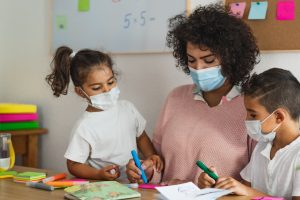Pritzker mandates vaccine for day care workers
By Jerry Nowicki Capitol News Illinois — October 22, 2021
Day care professionals will be required to receive their first dose by Dec. 3, and their second by Jan. 3. Those not fully vaccinated by Dec. 3 will have to submit to weekly COVID-19 testing until they are fully vaccinated, according to the governor’s office.
SPRINGFIELD – Gov. J.B. Pritzker announced an executive order Friday, Oct. 23 that will add day care personnel to the list of professions that must either be vaccinated against COVID-19 or submit to weekly testing.
The governor’s office said it expects the order to affect 55,000 individuals in the state, although many of them may have already received a vaccine.
“Vaccinations offer life-saving protection for the people who receive them and make the community safer for the people who can’t — including the babies, toddlers, and young children not yet eligible for the vaccine,” Pritzker said in a news release. “By extending vaccine-or-test requirements to those who work at licensed day care centers, we are adding another level of protection for our youngest residents and preventing outbreaks in daycare centers as more and more parents return to work.”
Children under 12 are not yet eligible to receive any of the approved vaccines in the U.S., although Pfizer has asked federal regulators to approve its vaccines for children aged 5 to 11. Children 12 years of age and older are currently eligible for that vaccine.
Day care professionals will be required to receive their first dose by Dec. 3, and their second by Jan. 3. Those not fully vaccinated by Dec. 3 will have to submit to weekly COVID-19 testing until they are fully vaccinated, according to the governor’s office.
There are 2,872 day care centers in Illinois that are licensed through the Department of Children and Family Services, the governor’s office said in a news release.
Since August, the governor’s office has mandated the same vaccine or testing requirements for health care professionals, teachers and staff at Pre-K-12 schools, higher education personnel and students, and a number of state workers.
On Wednesday, the governor’s office announced it had reached an agreement with a fifth state employee union, bringing the number of union employees covered by vaccine agreements to nearly 2,100.
The latest agreement with the Teamsters union covers equipment operators and maintenance workers at the Illinois Department of Human Services and Illinois Department of Veterans’ Affairs, about 100 workers in total, according to the governor’s office.
They join the VR-704 union, the Illinois Nurses Association, the Illinois Federation of Public Employees and Illinois Trade Unions as those covered in agreements with the state.
Per those agreements, employees will receive an additional personal day, and may be compensated at their regular pay for the time taken to receive the vaccine if none is available off work hours. Vaccinated employees may also receive paid time off if they contract COVID-19.
Those employees have an Oct. 26 deadline for their first vaccine, while the second dose must be received by the end of November. Negotiations are ongoing with the state’s largest public employee union, the American Federation of State, County and Municipal Employees Council 31, or AFSCME.
That union represents 39,000 state workers – including about 20,000 covered by the executive order.
The governor’s vaccine mandates were first issued in late August amid a surge of the COVID-19 delta variant that has proven about twice as transmissible as the first wave of the virus.
On Aug. 26, when the governor issued the order, the rolling case positivity rate for COVID-19 tests was 5.4 percent.
Virus transmission rates have ticked downward since that time, and the case positivity rate sat at 2 percent as of Friday. That number is still well above the mid-June lows of 0.6 percent.
As of Friday, 63.4 percent of the state’s age 12 and over population had been fully vaccinated.
Hospitalizations for the virus have ticked downward as well. As of Thursday night, Oct. 22 there were 1,277 individuals hospitalized with COVID-19 in Illinois, down from a stretch of several days above 2,300 in September during the most recent surge.
There were 323 intensive care unit beds in use by COVID-19 patients, down from more than 560 in September. That included 152 ventilators in use by COVID-19 patients, down from more than 340 in September.
jnowicki@capitolnewsillinois.com







